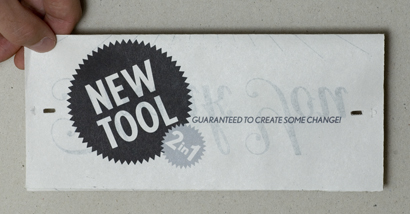
Last week I tried to relate what we are doing to a biological system, using Richard Dawkins concept of a meme as a starting point. It was a fun exercise, and learning experience.
Tonight I’m going to see how this depletist project fits into network theory. Again, please bare with me as I am no expert in network theory, but I did spend a good part of the day reading up on it. If you by chance are an expert of network theory I’d love to hear what you think, heck even if you aren’t an expert I’d still love to hear what you think.
Here we go…
Environmentalism has always seemed like an all or nothing deal to me. I have found myself asking why should I stop driving when no one else is going to stop? Why pay more for green power if everyone isn’t going to?
This is dangerous thinking. This logic is seen when people buy bigger cars for safety (thus requiring the next person using this logic to buy an even bigger one, etc), also when countries have nuclear weapons (if country x has one then country y thinks they need one to protect themselves, so country z thinks they need one to protect themselves from x and y, etc.)
This phenomenon uses logic skewed through a lens of fear. What if we exploited this form of logic for a good cause. If we used this logic, but skewed it through a lens of faith, to create positive change. The faith I am talking about has nothing to do with religion, it is a faith in man to make a decision beyond short term gain. This made me ask, is it our lack of faith in others that holds us back from embracing environmentalism?
As I learned today on wikipedia there are two kinds of economic value to be concerned about when thinking of network effects:
1) Inherent – My value from my using the product
2) Network – my value from your using the product
The network value can then be subdivided:
2.1) Direct Network Value is an immediate result of others adopting the same system (i.e.. e-mail).
2.2) Indirect Network Value is the secondary result of many people using the same system.
Let’s look at network theory in context to this project. Economic value can be seen as positive environmental change, so an increase in economic value is an increase in positive environmental change. The product is the word / thought depletist, and the network is society. We can look at system as being analogous with environmental lifestyle.
What is the inherent and network value of this project? My value from using the word is that I have a tool to label both people and actions (of others and my own). This allows me to identify concisely when something is going against the system, giving me an opportunity to avoid or condemn the activity. The networks value increases because I am using a tool to forward the goal of the system.
This will (hopefully) create a positive network effect. The more people using the word the more powerful it becomes. A common example of a positive network effect is telephones. If one person has one, there is no value, but as the number of users increase the value (usefulness) of having a phone increases. There is also the possibility of negative network effects. In the case of phones, a busy signal is an example of negative network effects. This is a result of limited resources. I don’t think a word / thought can run into issues of limited resources, but feel free to prove me wrong…

There are a few equations (the most well known being Matcalfe’s law) that try to define the value of a network based on the number of users, but it seems to be a bit inconclusive as to whether it proves the actual or potential value of a network.
Are environmentalist like phones? If there is only one environmentalist they aren’t going to make a difference, but as their numbers increase they become more powerful. So how can we get people to jump on the bandwagon?
This got me wondering how bandwagons exist in western culture when we are all striving for individuality? Are the bandwagon just getting smaller than they used to be? Two things that are thriving in our culture are MySpace and the iPod. I think one of their keys to success is that they foster individuality. They both offer a space that can be filled with whatever the owner feels represents them.
The problem with bandwagons is that they require everyone to listen to the same band. How can the environmental movement foster individuality within certain guidelines. I think I’m started to veer of in another direction here, but it might be worth coming back to another day…
Back to network theory…
In network theory there is something called positive feedback, essentially the more people that use a product, the more people that want to use the product. This causes the network to grow more quickly as time passes. I gave an example of positive feedback when I talked about people buying increasingly bigger cars. That was based on fear, what if we created a positive feedback system on faith (I believe that if I do recycling other people will too). This will create a domino effect (the domino effect indicates that some change, small in itself, will cause a similar change nearby, which then will cause another similar change, and so on in linear sequence, by analogy to a falling row of dominos standing on end – wikipedia). I think in this case it has the potential for exponential change. Another example of positive feedback occurs when people vote for a politician who appears to be in the lead, thus increasing the voters odds of being on the winners side, and the politicians odds of winning. In positive feedback loops preference increases as popularity increases.
I wonder how long this loop can sustain itself? Especially in our culture, where as soon as something becomes too cool it’s popularity quickly drops.
Does sustainability not deserve a sustainable solution?
I think this post might offer more questions then solutions (I suppose it would be stranger if I had more solutions than questions…)
I guess what I’m trying to say is have faith that your little (or big) changes have the ability to start the dominos falling, and as more people see the dominos falling the more they will want to be a part of it, thus creating a positive feedback loop and increasing the value of our network.
Love to hear what you think, good and bad.
-Chris
ps. A few topics I’m going to be reading up on, and hopefully writing on in the next week or so; Tipping Point (Mark Granovetter), Media Ecology (Marshall Mcluhan), and Flock and Flow – predicting and managing change in a dynamic marketplace (Grant McCracken). I’ve really appreciated the suggested readings in the comments, I’d love to hear more.








